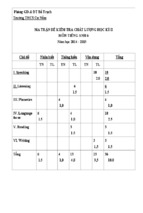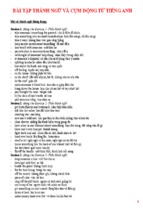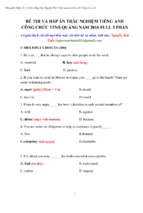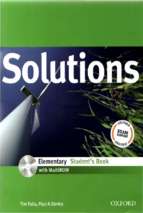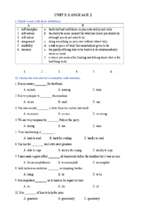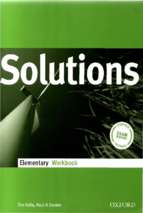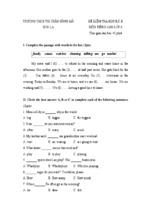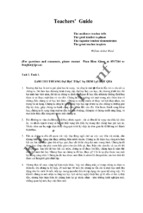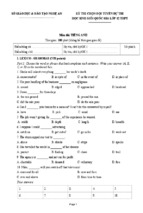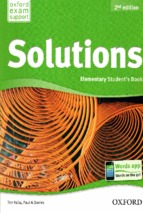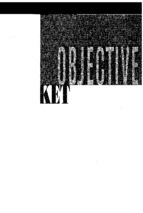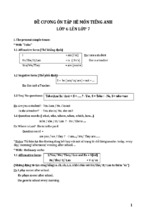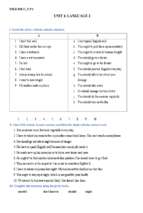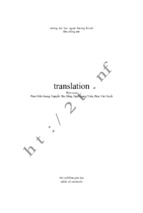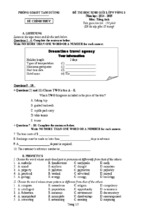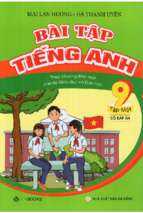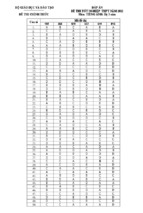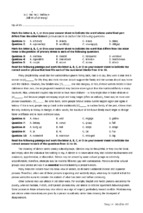de thi chon học sinh gioi lớp 12 cấp tỉnh môn tiếng anh
Research theme: Designing an extra reading program for grade 10 learners
to better their English
I. INTRODUCTION
1. Rationale of the study
It is commonly known that English has become one of the most important
languages in the world. It has trickled even into lesser-known countries as
something that is needed to communicate with others. In Vietnam, especially
now in the time of integrating into the process of globalization of the world
economy, English has been considered more important than ever before. At
schools, it has been a compulsory subject for quite many years. However,
learners’ attitudes to this subject are hostile because of their incompetence in
English from lower schools, which makes them unconfident in using English as
means of communication. According to the time allocation, moreover, the school
time for English lessons is limited with only 3 periods a week, each lasts 45
minutes. In an academic year, students complete 10 units, in which there are 10
reading lessons. Although these reading lessons are of various and interesting
topics with numerous updated range of vocabulary, most of them are written or
redesigned by Vietnamese writers, not the authentic ones. From my own
experience, I assume that in learning English, the more exposure to reading,
especially to authentic ones, the more progress the learners make in their
English. This is because of a number of benefits that reading brings about such
as vocabulary expansion, better writing skill. Therefore, I thought of designing
an extra reading program for my students to follow at home so that they have
more access to reading materials, thereby improve their English.
2. Aims of the study
The study aimed at seeing whether the reading program is beneficial for
my students. Specifically, the aims include:
2.1. Seeing if I can apply the reading program in my context.
2.2. Seeing if my students expand their vocabulary.
2.3. Seeing on how many students I can continue the reading program.
3. Background to the study
In this school year, I am responsible for teaching English to class 10C1
(English pilot program under the requirement of Thanh Hoa Department of
Education and Training) at Nong Cong 1 high school which is located in Nong
Cong town, Thanh Hoa province. As not majoring in English, they are offered
1
no extra classes besides the three 45-minute periods per week, which may not be
enough for their need to use English. With the desire of helping my students
with more reading materials, I conducted this study within two months. In order
to carry out my research, I planned a reading program, in which there were a
number of stories including funny stories, fairy tales such as The Lizard And The
Damsel, and the famous short story Love of Life by Jack London. The aim in
using stories is to entertain and stimulate the spirits of learning English among
my students. Also, because of their quite heavy workload at major subjects, I
gave them short passages first, longer ones later, and one by one every week, not
all at the same time so that the research did not affect their study much.
4. Research problem
With a view to finding out if I can do something to develop my students'
English, I conducted the research entitled " Designing an extra reading program
for grade 10 learners to better their English " among my 46 students.
The research was carried out to find answers to the following questions:
4.1. To what extent do the students enjoy the program?
4.2. To what extent do the students increase their vocabulary range?
4.3. How many students would like to continue the program?
5. Research design
The research study is organized into three parts as followed:
Part 1 provides basic information including the rationale, aims,
background, research questions, and research design.
Part 2 reviews the related literature on the benefits of reading as
well as presents the methods used to collect the data, also some
training needed before applying the program.
Part 3 involves the result analysis as well as the discussion of the
data and draws the conclusion on the subject matter and
suggestions for further research.
2
II. DEVELOPMENT
1. Literature Review:
Reading is an all-important language skill that is now in more demand than in
any time in our history. According to Anderson (1999), reading is the process of
looking at a series of written symbols and getting meaning from them. When we read,
we use our eyes to receive written symbols (letters, punctuation marks and spaces)
and we use our brain to convert them into words, sentences and paragraphs that
communicate something to us. Brown (1994) confirms that if you want to improve
reading comprehension, you should have reading skills. She also stresses that reading
comprehension means after reading, you can understand or interpret the text, or you
have to understand the author’s message. Sharing the same idea, Pressley &
Afflerbach (1995) confirms that skilled readers not only read, but interact with the
text. Mayer (2003) defines reading comprehension is techniques for improving
students' success in extracting useful knowledge from the text. A reading expert,
Ulijin (1985) defines reading comprehension as:
The holistic process of constructing meaning from written text
through the interaction of (1) the knowledge the reader brings
to the text, i.e., word recognition ability, world knowledge, and
knowledge of linguistic conventions; (2) the reader's
interpretation of the language that the writer used in
constructing the text; and (3) the situation in which the text is
read. (p.64-69)
It is undeniable that reading is of much importance as far as learning
English is concerned. Reading is something that you can do on your own and
that greatly broadens your vocabulary, thus helping you in speaking, listening
and writing. Reading is therefore a highly valuable skill and activity, and it is
recommended that English learners try to read as much as possible in English.
Educational researchers have found that there is a strong correlation between
reading and academic success. In other words, a student who is a good reader is
more likely to do well in school and pass exams than a student who is a weak
reader. This is not very surprising, since the best way to acquire a large
vocabulary is to read extensively, and if you read extensively you are likely to
be or become a good reader, and then a better writer. According to Smith (2004),
the more we read, the more we are able to read. Every time a reader meets a new
word, something new is likely to be learned about the identification and
meaning of words. Every time a new text is read, something new is likely to be
learned about reading different kinds of text. Learning to read is not a process of
building up a repertoire of specific skills, which make all kinds of reading
3
possible. Instead, experience increases the ability to read different kinds of text.
For al these reasons, it is vital that learners read constantly for the sake of
obtaining a significant number of benefits attained from reading as just a few of
which are listed below.
1.1. Vocabulary Expansion
This goes with the idea: the more English learners read, the more words
they gain exposure to, and they will inevitably make their way into their
everyday vocabulary. Being articulate and well spoken is of great help in any
profession, and knowing that they can speak to higher-ups with self-confidence
can be an enormous boost to their self-esteem. It could even aid in their career,
as those who are well-read, well-spoken, and knowledgeable on a variety of
topics tend to get promotions more quickly (and more often) than those with
smaller vocabularies and lack of awareness of literature, scientific
breakthroughs, and global events. Experts advise people, and most importantly
students, to indulge in at least half an hour of reading a day to expose
themselves to numerous styles of writing and to learn new vocabulary. An
improved vocabulary is the most obvious outcome of a strongly established
habit of reading because while reading books, especially challenging ones, you
will find yourself exposed to many new words you wouldn’t be otherwise.
1.2. Knowledge
Everything students read fills their heads with new bits of information,
and they never know when it might come in handy. The more knowledge they
have, the better equipped they are to tackle any challenge they will ever face.
Additionally, there is a bit of food for thought: should we ever find ourselves in
dire circumstances, remember that although we might lose everything else - our
job, our possessions, our money, even our health - knowledge can never be taken
from us. So, the more we read, the better it is.
1.3. Better Writing Skills
Clearly, an improved vocabulary and increase of knowledge are direct
results of an established habit of reading; these benefits together create a third
benefit of reading books. With the aid of an increased vocabulary and
knowledge, a writer has a better chance at creating an acceptable, if not
excellent, piece of written work. All successful writers will declare that in order
to succeed as a writer, one needs to read, every day. It is explained that while
reading you unconsciously absorb the grammar and style of the author. Great
authors have a tendency to take over your mind. This influence carries over to
writing, helping form clear, rhythmic sentences. Books have the power to
4
influence people, often for short lengths of time; even so, a writer’s style of
writing can easily be carried out onto a reader’s own style of writing. This
causes the reader to develop a fusion of their own style and an author’s style of
writing, if only for a short time. Thus, to a certain degree, students' writings may
be improved as a result of exposure to more reading.
1.4. Memory Improvement
Memory and reading are in close interaction with one another, reading
significantly helps improve memory at a young age in life and later on in one’s
older years. Poor long-term memory can cause difficulties with reading or
reading comprehension. Reading books “helps you stretch your memory
muscles because it requires you remembering details, facts and figures in
literature, plot lines, themes, and characters. When one reaches a certain age
where they no longer have a long-term memory, it becomes exceedingly difficult
to successfully read an entire book. This is due to the fact that with poor longterm memory, the reader often does not remember which lines he or she has
already read and may find they repeatedly read the same line or page on a book.
1.5. Stronger Analytical Thinking Skills
It is recognized that those who take an active involvement in reading have
higher intelligence, and general knowledge than those who do not. Reading is an
indulgence that enhances our knowledge by making us use our brain and causing
us to think more and therefore enhancing our intelligence. Since books help
improve both memory and concentration, one can say that reading makes it
easier to study a subject and retain the knowledge received from the subject,
thus directly making someone more knowledgeable. If one can spot patterns at a
faster rate, then analytical skills are enhanced by speed. Books are used nearly
every day in schools to teach difficult subjects, there is a reason why schools of
all grades assign a variety of textbooks. This is because books hold a variety of
information within their pages, of all subjects. To some, this may seem
preposterous but the matter of fact is that different authors know different kinds
of knowledge, and by exposing oneself to a large variety of books and absorbing
their information with understanding, one can easily become an expert in a
chosen subject.
In short, from a variety of advantages that reading offers, I would like to
apply the reading program into my context with the hope that my students will
benefit from it.
2. Methodology:
5
2.1. Participants
The participants were 46 students from class 10C1 from every corner of
Nong Cong district, by this I mean they are both from town and rural areas. 22
of them are females and they are 16 years old. They have been learning English
for more than 5 years. According to their school report when they were at grade
9, 5 of them were ranked as very good, 7 as good, 22 as average, and 12 as poor
at using English.
2.2. Instruments
The current study is conducted by using a questionnaire when the study
was over for data collection. The four-item questionnaire in this study (see
appendix 1) aimed at finding out if the reading program is beneficial for my
students. Specifically, item 1 was addressed to the theme of whether my students
enjoy the program or not; item 2 to the theme of how many new words/phrases
they encounter during their reading; item 3 to the theme of whether they would
like to continue the program, and item 4 to any suggestions they want to make.
Additionally, the researcher collected students' assignments as a tool for
analysis of the study.
2.3. Training
Before applying the program, some training was needed for its best
effectiveness.
Firstly, I made emphasis on the benefits of reading to any English
learners. The reading program includes various stories ranging from funny
stories to fairy tales and short stories, which are quite interesting and
meaningful. They not only help improve their English but also entertain them
after hard work at school. The stories which I choose are reasonable in length so
that they will not take students much time. Otherwise, they may get bored with
my research. The reading program was conducted within 6 weeks (from 10 th to
15th week of 1st term in 2014) with the outline as follows. (see in the next page)
Numbers
Week
Stories
6
1
1
1 funny stories
2
2
1 funny stories
3
3
The tortoises' picnic
4
4
The lizard and the damsel
5
5
The three enchanted oranges
6
6
The little red riding hood & The vain little mouse
At the beginning of each week, I gave my students the handouts and
asked them to read the stories, then translate them into Vietnamese while at the
same time write down all the new words/phrases/structures which they
encounter in notebooks, which I will collect at the end of the study
III. CONCLUSION
7
1. The result analysis and introduction:
After collecting data from the two kinds of instruments applied in the
language class I am teaching, I have come to some findings that will be helpful
for teaching and learning English. The results are as: Almost students enjoy the
reading program, all of the students increase their vocabulary range, and quite
many of them would like to continue the reading program.
With regard to the initial result, when designed to seek for students'
responses to the question: "Do the students enjoy the program?" the first item in
my questionnaire was addressed to see whether students found the reading
program beneficial. Happily, I had the result as follows.
Table 1: Students' attitude to the reading program
Item
number
Item
Responses
%
1
Did you find the reading program
beneficial?
Yes
91
No
9
As can be seen from the table, 91 per cent (= 42 participants) gave
affirmative answer to this item, which showed that most of them enjoyed the
program.
I continued my questionnaire with the second item, the result of which is
presented in table 2 below. (see in the next page)
Table 2: The number of new words/phrases participants achieved in each week's
reading stories
Classes Participants W1
10C1
W2
W3
W4
W5
W6
Total
1
0
3
8
7
5
10
33
2
0
3
7
8
3
14
35
3
1
4
2
7
6
0
20
4
2
3
7
8
4
10
34
5
2
3
8
5
13
11
42
Key: W: Week
8
The table reveals the number of new words/phrases shown by 10 students
whom I chose randomly from both classes. (I made this random choice because
it will take much time if I present all the 46 participants' result here). Among
these selected participants, the one who had the highest number of new
words/phrases is participant number 7 with the total of 52 words. It was then
followed by those with 42, 35, 34, 33, 20 respectively. It means all of these five
participants had expanded their vocabulary during their reading. Additionally,
when I checked the rest, the one who had the lowest number of new
words/phrases is with 9 words. There are many students whose new
words/phrases are written clearly with their word family. For example, in a
participant's assignment from class 10C1, what he wrote down in week 2 is as
follows:
coat (n): áo choàng
- a coat of paint: lớp sơn
- coat of mail: áo giáp
- to dust someone's coat: đánh ai một trận
- It is not the gay coat that makes the gentlemen: đừng lấy bề ngoài ...
pocket (n): túi
- to suffer in one's pocket: tiêu tốn tiền
- an empty pocket
- air pocket: lỗ thủng khí
- to pick someone's pocket: móc túi ai
In short, from the above data, it can be said that all of the participants
increase their vocabulary range thanks to the reading program.
Item number three in the questionnaire aimed at finding out how many
students would like to continue the reading program, and what their suggestions
were if they had. Table 3 below illustrates the results received for item 3.
Table 3: The number of students who would like to continue the program
Item
number
Item
Responses
%
3
Would you like the reading program to be
continued?
Yes
65.2
No
34.8
9
Although 91 percent of the participants found the study beneficial, 65.2
per cent of them (= 30 students) want to continue the program. I did not ask for
the reason why because this is actually an extra one designed to help those who
have passion for English. 65.2 per cent is really an encouraging figure as
English, in my school, is not their major subject. When coming to the
suggestions they want to make, I had some like this: "I think you should give us
such stories like Love of Life by Jack London. This is a very useful story, which
not only helps increase vocabulary but also helps understand a literary work
from which I learn the will of overcoming the hardship of life." or "I prefer short
stories to funny stories and fairy tales".
All in all, after analyzing the questionnaire, I am confident to come to the
conclusion that almost my students enjoy the reading program, which helps
improve their English to a certain extent. What I can do next is to design another
program for 65.2 percent of the students who have interest in their English
enhancement.
2. Conclusions and Recommendation:
In this final part, I would like to summarize what have been mentioned in
the previous chapters and offer some concluding remarks.
In the introductory part, the reasons for carrying out this research are
clearly presented. They are the requirements of more authentic reading
materials, more vocabulary and better use of English. All of these reasons
inspired me to implement a study on applying a reading program in my context.
In part 2, the literature review on the definition of reading as well as its
benefits is presented. Different views from different researchers are mentioned.
Although there are a lot of advantages, I mention only five of them.
The methodology as well as the analysis and discussion of the data is
shown in part 3 and 4. With the instruments used, I could collect relevant
information to analyze and discuss the data, the results of which revealed that
my efforts were rewarding.
In conclusion, it is undeniable that reading is of vital importance,
especially for the learners of English. Therefore, students should be encouraged
to read as much as possible and helped with relevant materials so that they can
earn full benefits from them. For the program like this to be carried out, it
requires the teacher to have various and relevant materials, then the time to
check students' assignments, to help them with any difficulties, etc. It is a timeconsuming activity, but it might bring about fruitful results for not only students
but also teachers in the learning and teaching English. From my own experience,
10
I find it possible and effective to use such program as an extra one for students
to follow at home.
However, this study was carried out for the first time among my 46
students from class 10C1. By this I mean the result may be different if it is
applied in other classes. Moreover, the stories used in the program might not be
interesting enough, which requires me to redesign it if I conduct the research
again in another context. Hopefully, further research on this with extensive
application will be conducted so that any teachers from any schools can explore
its benefits for this effective teaching and learning of English.
Hereby, I certify that I myself have done this research and I am capable
of being responsible for this paper in the future if it can be proved of containing
other people’s idea.
SIGNATURE OF PRINCIPAL
Thanh Hoa, May 15th, 2015
WRITER
Trần Thị Khánh Toàn
11
REFERENCES
Anderson, N. (1999). Exploring second language reading: issues and strategies.
Heinle & Heinle. 53-56.
Brown, H. D. (1994). Principles of language learning and teaching. Englewood
Cliffs, NJ: Prentice Hall Regents.
Draper, C.G. Great American Stories
Hill, L.A. (1965): Intermediate stories for reproduction. Oxford: Oxford
University Press.
Jaro, J. & Saraberri, S.(1995). Storytelling. Scotland: Macmillan Heinemann.
Mayer, Richard. (2003). Learning and Instruction. Upper Saddle River, New
Jersey: Pearson Education, Inc.
Smith, F. (2004). Understanding Reading: A Psycholinguistic Analysis of
Reading and Learning. Lawrence Erlbaum
12
Experience and Initiatives in
Designing extra reading program for grade 10
learners to better their English.
13
- Xem thêm -

